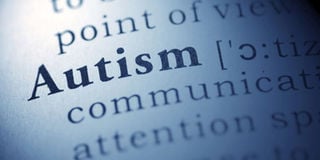How do you tell your child has autism disorder?

Autism has a broad spectrum, which is why people with it behave differently.
Autism is not a single disorder, but a spectrum of closely-related disorders with a shared core of symptoms.
Autism is a lifelong developmental condition that affects, among other things, the way an individual relates to his or her environment and their interaction with other people. The word “spectrum” describes the range of difficulties that children with autism may experience and the degree to which they may be affected.
Some children may be able to live relatively normal lives, while others may have an accompanying learning disability and require continued specialist support.
Every individual on the autism spectrum has problems to some degree with social skills, empathy, communication, and flexible behaviour. But the level of disability and the combination of symptoms varies tremendously from person to person. In fact, two children with the same diagnosis may look very different when it comes to their behaviour and abilities.
An example
Joel and Jada are fraternal twins who were born after an uncomplicated pregnancy. The twin’s parents, both trained as teachers, recall that Jada was somewhat colicky and that Joel seemed content in comparison. He seemed advanced in the first year of life compared with his sister.
Joel smiled and babbled on time, and his parents remember that from a very early age, he was quite interested in toys with letters or numbers. By the time he was one year old, Joel could identify some letters, and his parents thought he was rather precocious.
They noticed that by 15 months of age, however, Jada was using words and beginning to play appropriately with toys. Joel, conversely, had many words used as labels but never used “momma” or “dada” and seemed to be consumed with naming and ordering letters and numbers. He could repeat phrases from his parents but did not construct his own phrases at two years. At times, Joel’s parents worried that he was deaf because he seemed to ignore them.
The parents took Joel to the paediatrician who referred Joel to an early intervention programme. His hearing was normal, but he had significant delays in receptive and social language. Joel was diagnosed as having an Autism Spectrum Disorder (ASD).
Symptoms
The symptoms of ASDs are neurologically based. According to Muhle, Trentacoste and Rapin’s The Genetics of Autism, ASDs may occur in conjunction with other functionally defined diagnoses such as intellectual disability and learning disabilities, biologically based behaviours such as tics, and medical conditions like epilepsy. Below are some of the core features of autism:
The most severely affected individuals seem to be aloof and uninterested in people. Others desire contact, but fail to understand the reciprocal nature of normal social interaction. In consequence their attempts at social interaction are clumsy, awkward and one – sided. Some passively accept the attentions of others but do not reciprocate.
The whole range of communication skills may be affected. A significant proportion of individuals with classical autism fail to develop useful speech.
Even when the mechanics of language are mastered, the person with autism has difficulty using it for the purpose of communicating with others. Intonation is inclined to be abnormal and the non-verbal aspects of communication such as eye-to-eye, use of gesture and facial expression can be impaired.
People with autism have great difficulty thinking imaginatively. This is demonstrated by pretend play, which will be absent or repetitive in children with autism spectrum disorders. Whether this is directly related to the development of rigid and repetitive behaviours, has not been established.
Learning disabilities are also common among individuals with Autism Spectrum Disorders.
People with autism can have different degrees of learning disability, which can affect all aspects of their life, from studying in school to learning how to wash themselves or make a meal. Some people will be able to live fairly independently - although they may need a degree of support to achieve this - while others may require lifelong, specialist support.
People may be familiar with the image of children with autism obsessively lining up toys, repeatedly spinning objects or flapping their hands in the periphery of their vision. As development proceeds, however, the focus of attention tends to shift from physical activities to the collection of information. This is particularly true of more able children who may accumulate facts about specific topics.
ASDs are neurodevelopmental disorders with a genetic basis, the presentation of which might be modified by environmental factors.
These disorders are characterised by abnormalities in communication, social interaction and repetitive interests and behaviors. Children with ASDs may have associated intellectual disability and severe communication impairments.
Although there is no known cure for autism, advances in early recognition and intervention have had positive impact on outcome and quality of life for people with ASDs and their families.
The writer works with a home that caters for children with an autism spectrum disorder.




